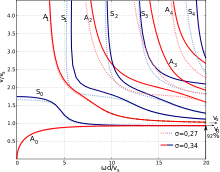Phase velocity
The phase velocity is the propagation velocity of equal phases of a monochromatic wave.
In dispersive media, waves of different frequencies propagate with different phase velocities. Consequently, when wave packets (i.e. the sum of several superimposed monochromatic waves) propagate in dispersive media, the phase differences between individual components are not constant but time-dependent: The shape of the wave packet changes (it "dissipates").
In the upper figure, the red dot moves with the phase velocity. In the second figure, a wave packet is shown whose group velocity is equal to the phase velocities of the individual components. In the third figure, the phase velocities of the individual components are different.
The phase velocity 


Based on the definitions of frequency 


The speed of light in a vacuum is the upper limit for the transmission speed of energy and information. However, there are numerous cases where phase velocities above the speed of light occur. Examples are matter waves and waves in waveguides.
.gif)
A wave packet propagates in a dispersive medium.
.gif)
A wave packet propagates in a non-dispersive medium (e.g. an electromagnetic wave in a vacuum).
The red dot is always at the point of the same phase (wave crest) and moves with the phase velocity of the blue, monochromatic wave.
The green points move at group speed, the red one at phase speed.
Relationship with group velocity and dispersion
| Designation | Symbol | Relationships | ||||
| Amplitude | |
| ||||
| Wave vector | | Direction of propagation | ||||
| Circular wave number | | | ||||
| Wavelength | | | ||||
| Circular frequency | |
| ||||
| Frequency | | | ||||
| Phase velocity | | | ||||
| Group speed | | | ||||
| Phase angle | | |
For the mathematical description of a wave in a special medium, one needs its waveform, amplitude, frequency, phase angle and the associated wave equation - if necessary with boundary conditions. Nevertheless, different velocities can be assigned to such a clearly defined wave, which should not be confused with the phase velocity.
The speed at which a wave transmits energy or information is the signal speed. For a lossless medium, this is equal to the group velocity, i.e. the velocity of a wave packet. Such a wave packet is composed of monochromatic waves with different frequencies 

The functional relationship between phase velocity and frequency is called dispersion.
For electromagnetic waves, the phase velocity 




Examples
Structure-borne sound
In solids, sound waves can propagate as structure-borne sound. The phase velocities vary depending on the wave type. For example, the phase velocity of the longitudinal wave at room temperature in stainless steel is about 5980 m/s; the phase velocity of the transverse wave is smaller by a factor of about 1.8: approx. 3300 m/s. In thin plates, other types of waves exist, so-called Lamb waves. In the adjacent picture, each branch corresponds to a Lamb wave type (mode). Vertically, the phase velocity 




Matter wave
According to the wave-particle duality, a particle, e.g. an electron with energy 



With Einstein's formula
or in the formulation with the Lorentz factor γ
and the definition of the relativistic momentum 
Here 


So the de Broglie phase velocity is always greater than the speed of light. This so-called superluminal velocity of matter waves does not contradict the theory of relativity, because the signal velocity 
Waveguide
Electromagnetic waves in normal waveguides used for power transmission also travel at phase velocities above the speed of light. In the traveling wave accelerator, the phase velocity must be artificially reduced to values below the speed of light by regularly arranged conductive apertures.
Questions and Answers
Q: What is phase velocity?
A: Phase velocity is the speed at which the phase of any one frequency component of a wave travels.
Q: How is phase velocity related to given phase of a wave?
A: Any given phase of the wave appears to travel at the phase velocity.
Q: Can phase velocity be calculated?
A: Yes, phase velocity can be calculated.
Q: In what terms is phase velocity given?
A: Phase velocity is given in terms of wavelength λ (lambda) and wave period T.
Q: What is wavelength?
A: Wavelength is the distance between two consecutive crests or troughs of a wave.
Q: What is wave period?
A: Wave period is the time it takes for a wave to complete one full cycle.
Q: Can phase velocity change with changes in wavelength and wave period?
A: Yes, phase velocity can change with changes in wavelength and wave period.
Search within the encyclopedia























